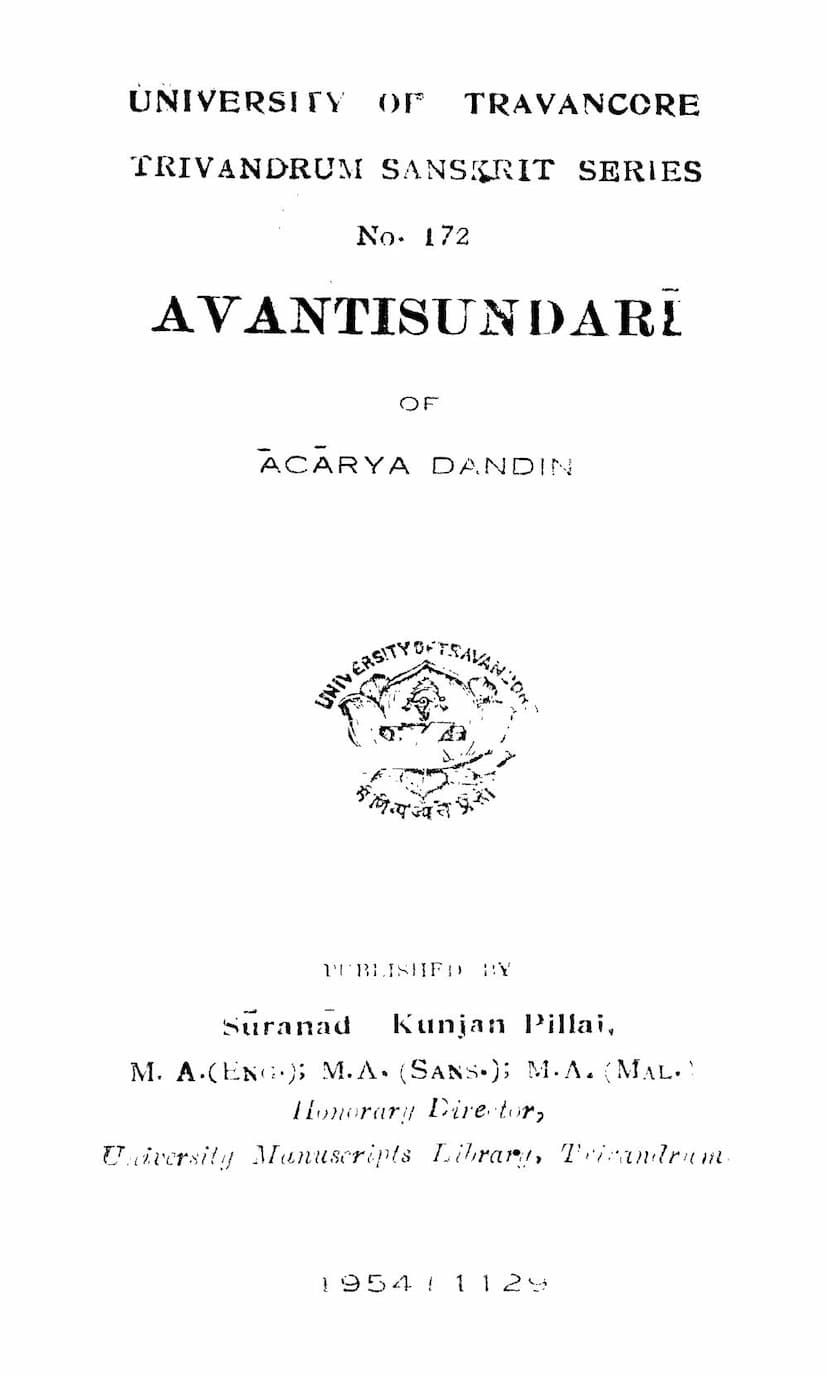Avantisundari
Added to library: September 1, 2025

Summary
Here's a comprehensive summary of the Jain text "Avantisundari" by Acharya Dandin, based on the provided catalog link and the preface and introduction of the published text:
Title: Avantisundari (Avantisundari Katha) Author: Acharya Dandin Publisher: Surnad Kunjan Pillai Series: University of Travancore Trivandrum Sanskrit Series, No. 172 Publication Year: 1954
I. Background and Significance:
- A Jewel of Sanskrit Prose Romance: The Avantisundari Kathā is considered a significant prose romance in Sanskrit literature, comparable to the works of Bāṇabhaṭṭa (Kādambarī) and Subandhu (Vāsavadattā).
- Authorship Debate: The text contributes to a scholarly debate surrounding the works of the renowned Sanskrit rhetorician and storyteller, Dandin. While his Kāvyādarśa is universally accepted, the authorship of other works like Daśakumāracarita, Mṛcchakaṭikā, Chandoviciti, Dvisandhāna, and Avantisundari is subject to discussion. The discovery of Avantisundari specifically attributed to Dandin has intensified this debate. Some scholars, like Dr. A. Berriedale Keith, argue for stylistic differences suggesting separate authors for Avantisundari and Daśakumāracarita, while others, like Dr. P. V. Kane, propose that Avantisundari might be the prelude or first part of the story that is continued in the Daśakumāracarita.
- Relationship with Daśakumāracarita: The preface highlights that, apart from some elaborations like genealogies and descriptions of islands, the core story of Avantisundari is largely identical to the Pūrvapithikā (introductory part) of the Daśakumāracarita. This similarity, along with manuscript colophons explicitly attributing both works to Dandin, strengthens the case for his authorship of both. However, significant differences in narrative details and style are noted, suggesting Avantisundari might be an earlier or altered version.
II. Content and Narrative:
- Autobiographical Introduction: The work begins with an autobiographical account of Dandin, describing his ancestry and the circumstances leading to his composition of the Avantisundari.
- Ancestry: Dandin traces his lineage to a Brahmin family from Anandapura, who migrated to Acalapura. His great-grandfather was Nārāyaṇasvāmin, his grandfather Damodara, and his father Manoratha. Manoratha's son was Viradatta, who married Gauri, and their son was Dandin.
- Damodara and Bharavi: The narrative mentions Damodara, Dandin's grandfather, becoming friends with Prince Viṣṇuvardhana through the influence of the great poet Bharavi. This establishes a connection between these historical figures.
- Early Life and Circumstances: Dandin recounts losing his father at a young age and being forced to leave Kāñcīpura due to enemy attacks. He wandered, studied under various teachers, and returned when peace was restored.
- The Story of Avantisundari: The core of the work narrates the story of Avantisundari. A key episode described is Dandin's encounter with a renowned architect named Lalitālaya.
- Architectural Challenge: Lalitālaya requests Dandin to examine his repair work on a statue's forearm in Mahāballapuram. This request leads Dandin to travel to Mahāballapuram.
- Supernatural Event: At Mahāballapuram, a divine fragrance leads Dandin and his friends to a lotus flower washed ashore. The lotus transforms into a Vidyādhara, who bows to a Visnu idol and disappears.
- Divine Revelation: To understand this miraculous event, Dandin performs a special puja. In a dream, the Goddess of Learning appears and blesses him with the revelation of the story of Rājavāhana, the king of the Vidyādharas.
- Narration of the Story: The next morning, Dandin begins narrating the story of Avantisundari to his friends. The available manuscript, however, is incomplete and ends with the narration of Kadambarī's tale by Mandākini.
III. Scholarly Discussion and Context:
- Works of Dandin: The introduction delves into the identification of Dandin's three reputed works mentioned by Rājasekhara:
- Kāvyādarśa: Universally attributed.
- Daśakumāracarita: Generally accepted by most scholars.
- The Third Work: This is where the debate intensifies. Various candidates like Mṛcchakaṭikā, Chandoviciti, Kalapariccheda, and Dvisandhāna are discussed, with the discovery of Avantisundari adding another layer to this puzzle.
- Internal Evidence and Dating: The text discusses Dandin's potential dating based on internal evidence within Avantisundari. The mention of contemporaries like Simhavishnu (Pallava king, 575-600 AD), Durvinita (Ganga king, 605-650 AD), Vishnuvardhana (Eastern Chalukya king, 615-633 AD), and Bharavi allows scholars to place Dandin in the late 7th or early 8th century AD.
- Manuscript Issues: The preface acknowledges that the present edition is based on a defective and fragmentary manuscript (No. 10863), which is incomplete and contains numerous lacunae and scribal errors. The publication was undertaken despite these shortcomings due to the immense interest such a work holds for students of Sanskrit literature.
IV. Key Themes and Style:
- Narrative Richness: Like other major Sanskrit romances, Avantisundari is praised for its majestic style and engaging narration, although it incorporates some miraculous and improbable incidents.
- Genealogy and Historical Interest: The work offers valuable historical information, including the genealogy of the Lunar race of kings and the stories of figures like Vararuci, Kadambarī, and Samudradatta.
- Detailed Comparison with Daśakumāracarita: The text provides a detailed point-by-point comparison of narrative differences between Avantisundari and the Pūrvapithikā of Daśakumāracarita, highlighting variations in events, character actions, and the order of events. These discrepancies are presented as evidence for the scholarly debate on authorship and the nature of their relationship.
In essence, Avantisundari is a crucial text for understanding Dandin's oeuvre, offering a blend of historical, mythological, and literary elements within a captivating narrative framework, while also posing intriguing questions for scholars regarding its precise place in Sanskrit literature and its relationship with Dandin's more famous work, the Daśakumāracarita.